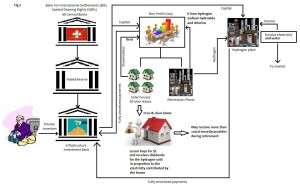July 30, 2017
Background
According to the 2016 World Economic Forum, “the Fourth Industrial Revolution, which includes developments in previously disjointed fields requiring college degrees such as artificial intelligence and machine-learning, robotics, nanotechnology, 3-D printing, and genetics and biotechnology, will cause widespread disruption not only to business models but also to labor markets over the next five years.”
Clearly these technologies are designed to increase short term profits by eliminating jobs. Therefore, absent a specific mechanism to counter their cumulative effect, workers worldwide are facing a painful transition of unprecedented magnitude as arduous, repetitive and even dangerous occupations are absorbed by the ongoing rise of the machines. Our government’s fixation on boosting military expenditures, which already exceed the next seven nations combined, its aversion to redistribute wealth, its undisguised eagerness to dismantle the last vestiges of FDR’s New Deal, and its staunch refusal to concede that climate change will force humanity, one way or another, to stop using fossil fuels, will toss future generations into a spiral of despair and hopelessness, a breeding ground for revolt.
The economy is the glue that binds modern societies into cohesive states. Accordingly, a majority of the people must have a reasonable share of income and wealth. Unfortunately a decline in disposable income, which is where we’re headed with the new technologies, will reduce the buying power of consumers, and they account for seventy percent of the U.S. economy. Therefore it behooves the government to organize, but not necessarily fund, a more egalitarian system designed to give most people the means to consume. That would be good for the government, which would collect more tax revenue and reduce safety net expenses, good for the working class, which would have the means to make ends meet, and good for the elite since the masses would have more disposable income to purchase their goods and services.
Enter Distributed Electricity
In 1880, at the height of the Victorian Era, Thomas Edison figured out how to create a pure vacuum in his bulbs, and in so doing, created the first marketable design. However, his revolutionary concoction required a permanent round-the-clock supply of electricity. In response, state-regulated, shareholder-owned power plants and distribution grid monopolies were created. Eventually the demand for electricity became so large that fossil fuels, particularly coal, had to be used. As with other for-profit enterprises, the new utilities had to compete in the capital markets. They did (and still do) that by offering competitive rates of return to shareholders based on the price of electricity. The system worked well because it had no real competition, until now.
It would be ludicrous and preposterous to suggest clinging to obsolete technologies such as steam locomotives, the telegraph, horse-drawn carriages and yes, centrally-generated electricity systems. And it’s not just a question of obsolescence. For the first time in history homo sapiens will have to adapt to the irresistible consequences of anthropogenic climate change, drought, sea level rise, depletion of aquifers, insufficient surface freshwater, potential famines, and the growing threat of terminal thermonuclear war.
Universal Basic (Avatar) Income
Universal Income is a necessity, however the government ought to organize and regulate, but not pay for it. In a nutshell, solar energy, hydrogen and gravity combined can potentially end using nuclear fission and fossil fuels to generate electricity. Public utilities could be relieved of their mandate to generate electricity. Instead, for a fee, they would operate, maintain and expand as needed the distribution grid. All new and existing residential, commercial and industrial buildings would be required to generate a surplus of electricity from solar power during daylight hours and be equipped with batteries for nighttime operation. Profits from the sale of electricity, hydrogen and freshwater would be distributed to property owners rather than utility shareholders. The profits would be used to help prospective and existing homeowners amortize their mortgages, end the housing crisis, create non-temporary well-paying jobs that cannot be outsourced or exported, and improve the economy at large. The system is explained in detail here.
